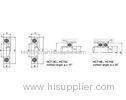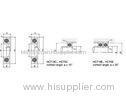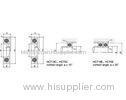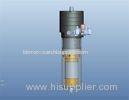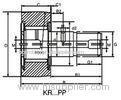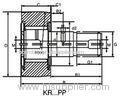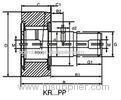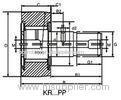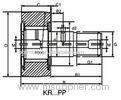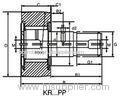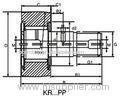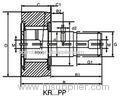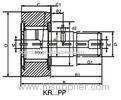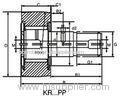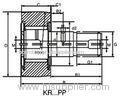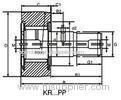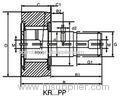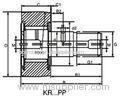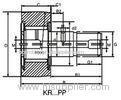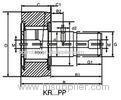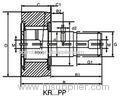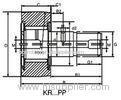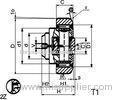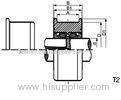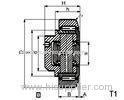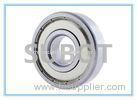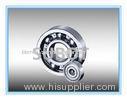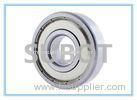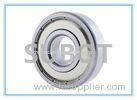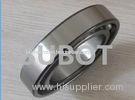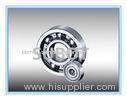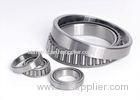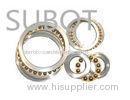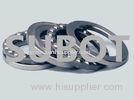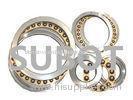lathe spindle bearings bridgeport spindle bearings
| Place of Origin: |
Zhejiang, China (Mainland) |
Product Detail
Precision Spindle Bearings for Accommodating Combined Loads: Ceramic balls HCS71900C.T.P4S.UL
<table border="0" cellpadding="0" cellspaci
Precision Spindle Bearings for Accommodating Combined Loads: Ceramic balls HCS71900C.T.P4S.UL
|
Characteristics of spindle bearings |
|
Spindle bearings are single row angular contact ball bearings comprising solid inner and outer rings and ball and cage assemblies with solid window cages. They cannot be dismantled. The bearings are available in both open and sealed versions. |
|
|
|
Spindle bearings have restricted tolerances. They are particularly suitable for where requires very high guidance accuracy and speed capacity, especially for slewing part of the main spindle of machine tool. |
|
|
|
Angular contact ball bearings have raceways in the inner and outer rings that are displaced with respect to each other in the direction of the bearing axis. This means that they are designed to accommodate combined loads, i.e. simultaneous radial and axial acting loads. |
|
|
|
The axial load carrying capacity of angular contact ball bearings increases with the enlarging of contact angle. The contact angle α is defined as the angle between the line joining contact point of the ball and the raceways in the radial plane, along which the load is transmitted from one raceway to another, and a line perpendicular to the bearing axis. |
|
|
|
Single row angular contact ball bearings can accommodate axial loads acting in one direction only. Under radial loads a force acting in the axial direction is engendered in the bearing, and this force must be counteracted. Consequently the bearing is normally adjusted via a second bearing. |
|
|
|
Single row angular contact ball bearings have one high and one low shoulder. Some bearings, particularly those of Diameter Series 8 and 9, have an inner ring with two high shoulders as a deep groove ball bearing. The low shoulder on one or both rings enables a large number of balls to be filled in the bearing, thus giving the bearings a relatively high load carrying capacity. They are of inseparable design. |
|
|
|
The contact angle αis 15°(C) or 25°(E), designation suffix C.T.P4S or E.T.P4S.F, for the most common sizes, the cage is a solid window type cage made of textile-laminated phenolic resin(T) and the tolerance class is P4S. Single row angular contact ball bearings are produced in two versions. |
|
|
|
- |
Bearings for universal matching
|
|
- |
basic design bearings(not universally matchable) can be only be used for arrangements with single bearings
|
|
|
|
|
|
|
Bearing Tolerances |
|
Bearing "tolerances" of dimensional and running accuracy, are regulated as ISO standard. For dimensional accuracy, these standards prescribe the necessary tolerances when installing bearings on shafts or in housings, consisting of the acceptable values for bore diameter, outer diameter, assembled bearing width, the permit chamfer, and tapered bore deviation. The geometry accuracy includs average bore diameter variation, outer diameter variation, average outer diameter parattelism, as well as raceway width and height variation(for thrust bearings). |
|
|
|
Running accuracy is defined as the allowable limits for bearing runout during operation, consisting of the acceptable values for inner and outer ring radial and axial runout, inner ring side runout, and outer diameter perpendicular deviation. |
|
|
|
Comparison of tolerance classifications of national standards |
|
Standard |
Applicable
Standard
|
Tolerance Class |
Bearing Types |
|
Chinese Industrial Standard(GB) |
GB 307.1 |
P0 |
P6 |
P5 |
P4 |
P2 |
All types |
|
International
Organization
for Standardization(ISO)
|
ISO 492 |
Class 6x |
Class 6 |
Class 5 |
Class 4 |
|
Radial bearings |
|
ISO 199 |
Normal class |
Class 6 |
Class 5 |
Class 4 |
|
Thrust ball bearings |
|
ISO 1224 |
|
|
Class 5A |
Class 4A |
|
Precision instrument bearings |
|
Deutsches institut for Normung(DIN) |
DIN 620 |
P0 |
P6 |
P5 |
P4 |
P2 |
All types |
|
|
|
|
|
|
Criteria for selecting bearing internal clearance |
|
A bearing's life is theoretically maximum when operating clearance is slighly negative at steady operation. In reality it however is difficult to constantly maintain this optimal condition.If the negative clearance becomes enlarged by fluctuant operating conditions, heat will be produced and bearing life will decrease dramatically. Under ordinary circumstances you should therefore select an initial internal clearance where the operating clearance is slightly larger than zero. |
|
|
|
For ordinary operating conditions that use fitting for ordinary loads, running speed and operating temperature are ordinary, selecting normal clearance enables you to obtain the proper operating clearance. |
|
|
|
Radial internal clearance for duplex angular contact ball bearings |
Unit:µm
|
Didn't find what you're looking for?
Post Buying Lead or contact
HiSupplier Customer Service Center
for help!
Related Search
Find more related products in following catalogs on Hisupplier.com
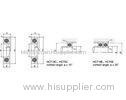
|







